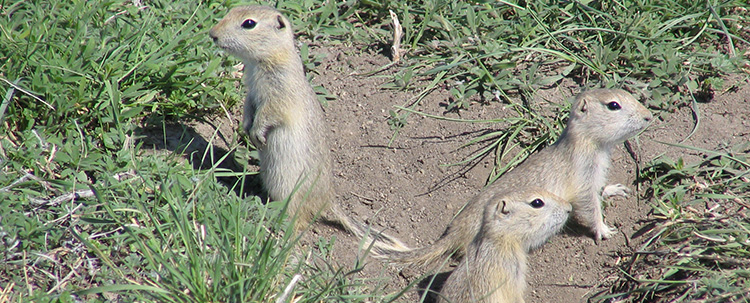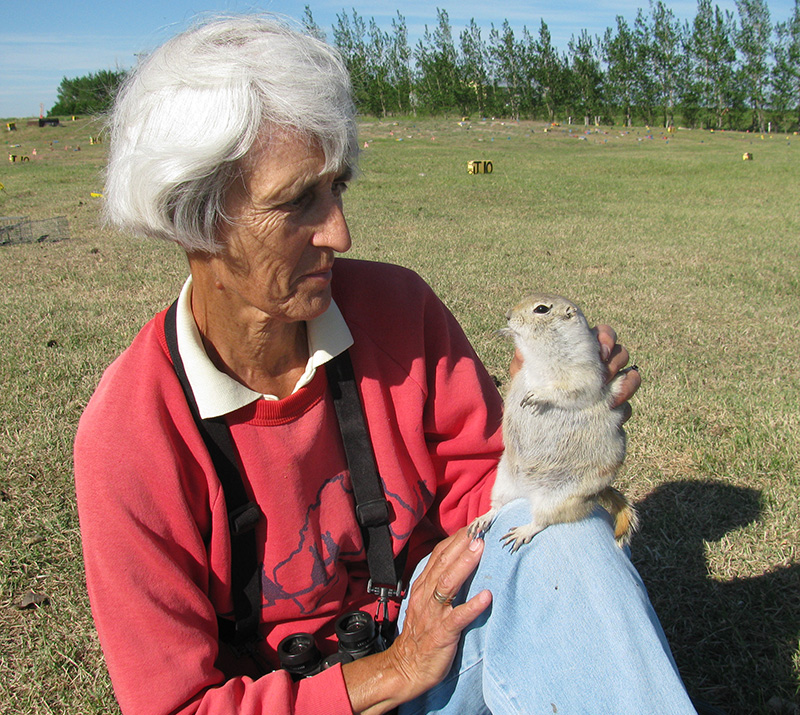Underground Life:
Did you know that Richardson’s ground squirrels spend most of their life hibernating?

BY GAIL MICHENER
When I came to Canada from Australia years ago, I had never heard of Richardson’s ground squirrels, not even by their more vernacular name of “gopher.” To me, these prairie residents were exotic animals, and I wanted to know about them.
I soon learned that Richardson’s ground squirrels are regularly seen above ground during daylight hours for seven to eight months of the year, but rarely from late October through late February, generating the perception that they hibernate for a four-month period encompassing winter. However, that perception is only partially accurate. Long-term studies reveal that juvenile males do indeed hibernate for four months, but their sisters, mother, and father all spend seven to eight months in hibernation. Winter does not last that long, so what accounts for such extraordinarily long hibernation seasons?
Teasing apart who hibernates when requires daily censusing of individually recognizable animals. Richardson’s ground squirrels can tell each other apart by a combination of odour and behaviour, but to us they all look alike. With no natural identifying features comparable to whisker patterns in lions or dorsal fin shape in orcas, I depend on a two-step identification system for my studies. A uniquely numbered earring in each ear provides lifetime identification, but the numerals are too small to be readable at a distance. A unique mark dyed on the fur facilitates identification for observational purposes, but requires renewal after each moult. In combination, these techniques ensure that I always know who is who and which individuals are present or absent.
Daily censuses quickly reveal four groupings of squirrels with dramatically different times of entry into hibernation. The first to hibernate are adult males, followed by adult females about two weeks later. Juvenile females do not hibernate for another five to six weeks, and a further two months later the juvenile males finally enter hibernation. Astonishingly, the majority of ground squirrels start hibernation when temperatures are increasing over summer.
From 25 years of censusing a population of Richardson’s ground squirrels near Lethbridge, I calculated the average dates that are most representative of the onset of hibernation in a typical year in southern Alberta. These dates are June 22 for adult males, July 4 for adult females, August 10 for juvenile females, and October 15 for young males. Calendar dates vary somewhat within cohorts, across years, and with geographic location, but everywhere in every year, adult males, adult females, and juvenile females enter hibernation in the summer months.
Hibernating as early as June seems preposterous. To be certain that summer-immerging animals were really going into hibernation, I radio-collared ground squirrels with units that emit a signal indicative both of underground location and body temperature. Within one or two days of cessation of above-ground activity, body temperature declines dramatically from the usual mammalian value of 37°C to closely match deep soil temperature. Typical body temperature of torpid squirrels in late June and July is 15–18°C, a temperature at which all bodily functions are very slow and the squirrel is inactive. The soil, and consequently the ground squirrel, grows gradually cooler through late summer, autumn, and into the depth of winter. Eventually body temperature during torpor levels off to near 0°C until emergence in spring.
Although the overall trend is for body temperature to decline steadily with soil temperature during hibernation, an important — and still not fully understood — phenomenon found in all hibernating ground-dwelling squirrels is for body temperature to rise to 37°C for about 12 hours every two to three weeks. Collectively these brief rewarming events account for only 5–10% of hibernation; the remainder of the time the squirrel is in cold torpor. Squirrels mostly sleep during the short inter-torpor intervals; they do not eat or leave the hibernation chamber.
Location data from radio-telemetry reveals that every individual hibernates alone in a dedicated site that is prepared in advance but reserved for hibernation. Because hibernacula are not reused, I can excavate and map architecture post-hibernation without depriving the owner. The hibernaculum system consists of a grass-lined spherical chamber 22–25 cm in diameter located about 55 cm deep. The chamber has a single opening connected to a tunnel that splits. One portion angles downward to a dead end and serves as a drain. The other portion curves upwards to about 12–15 cm below the surface, ending in a vertical “chimney” that connects to the surface. This connection is blocked with soil prior to beginning hibernation, completely entombing the hibernating squirrel.
Hibernation ends when the squirrel terminates torpor, excavates the route to the surface, and begins daily above-ground activity. The pattern of emergence from hibernation is simpler than that of immergence. Just two groups are identifiable. Males emerge first, with no distinction between older males that started hibernation in late June and young males that entered hibernation four months later in mid-October. About 15–20 days after male emergence, all females appear above ground more or less simultaneously, regardless of age. The typical calendar dates for emergence of males and females are February 22 and March 11, respectively.
Putting all the immergence and emergence dates from my southern Alberta population together, we can calculate the typical lengths of the active and hibernation seasons. Adult males and adult females have an active season of 115–125 days and a hibernation season of 240–250 days. Regardless of sex, adult Richardson’s ground squirrels spend two-thirds of their life hibernating.
In contrast to adults, durations of the active and hibernation seasons of juveniles differ greatly by sex. Juvenile females first enter hibernation at 120–130 days old, but their brothers wait until they are 180–200 days old. Hibernation lasts for 205–220 days for young females, accounting for two-thirds of the first year of life. For young males hibernation lasts only 120–140 days, about 40% of their first year.
Why do most Richardson’s ground squirrels spend the majority of their life in hibernation and why does each cohort have a different schedule?
The architecture of the hibernation system is a clue to the advantages of lengthy hibernation seasons that last longer than winter. Once interred underground in the closed system, Richardson’s ground squirrels no longer need to be wary of aerial predators such as Swainson’s hawks, surface predators such as coyotes, or underground predators such as long-tailed weasels. They are in a stable environment safe from all disturbances except badger predation, which can take a heavy toll on hibernating squirrels but only occurs about once or twice a decade. In the absence of badgers, 90% or more usually survive the hibernation season. An unintended benefit of underground seclusion is that hibernating ground squirrels are also safe from most control methods used by landowners.
The unifying factor that explains the four-month span of hibernation onset is the timing of the most energetically demanding period for each group: mating in March for adult males, lactation in April for adult females, growth until July for juvenile females, growth until September for juvenile males. When energy is no longer required for reproduction or growth, the rule is: fatten up and hibernate as quickly as possible. Why? Because hibernation offers the greatest security.
Nature obligingly provided me with a natural experiment that tests the notion that fattening to prepare for hibernation occurs as soon as there is no other large energetic demand. A few adult females experience reproductive loss; compared with mothers that wean a litter, those litterless females fatten and immerge in late June, in synchrony with adult males.
The energetic-demand hypothesis accounts for the four-month variation in immergence dates, but what accounts for the difference in emergence dates between sexes? Males use that two-week period to build up their body weight and strength and become fertile, all in readiness for the rigours of male-male competition for mates, which begins as soon as females emerge from hibernation.
Richardson’s ground squirrels are not unique among ground-dwelling squirrels in having several age and sex cohorts on different timetables, but they are exceptional in the extent of asynchrony. As a consequence, the only time of year when all Richardson’s ground squirrels are simultaneously visible is the six- to eight-week interval after litters emerge from the natal burrow in early May and before adult males immerge into hibernation in late June. Although we cannot readily distinguish a given squirrel’s age or sex at a distance, familiarity with the underground schedule provides clues to the knowledgeable observer as to who is active above ground.
Gail Michener received her B.Sc. from the University of Adelaide, Australia, and her PhD from the University of Saskatchewan. Aside from a couple of years teaching in Ghana, Gail has devoted her career to studying Richardson’s ground squirrels, mostly adjacent to her husband’s pedigreed seed farm in southern Alberta, while a faculty member at the University of Lethbridge.
This article originally ran in Nature Alberta Magazine - Summer 2020, Volume 50 | Number 2
